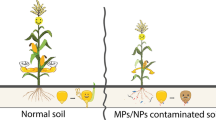Abstract
Transport of 42 polychlorobiphenyl (PCB) congeners by purple loosestrife (Lythrum salicaria) in two ecosystems is reported. The contaminated site was beside the Hudson River at Albany, New York, and the control site was two miles distant on wasteland. By transplanting and translocating the plants between the sites, systemic uptake from the roots and uptake from the air were determined. Uptake from ambient air was also measured with a 0.2-m3 field sampling chamber. The dominant route of uptake by the plant was via the roots. At high ambient concentrations (140 ng/m) PCB was scavenged from the air by the plants. At low ambient concentrations (8 ng/m3) 2-chlorobiphenyl and 2,2′-dichlorobiphenyl were emitted by the plants.
Similar content being viewed by others
References
Analytical Handbook, Toxicology Institute (1980) Polychlorinated biphenyls in ambient air. Division of Laboratories and Research. New York State Department of Health. Albany, NY
Buckley, EH (1982) Accumulation of airborne polychlorinated biphenyls in foliage. Science 216:520–522
— (1983) Decline of background PCB concentrations in vegetation in New York State. Northeastern Environ Sci 2(3/4):181–187
Brown, JF, Wagner, RE, Bedard, DL, Brennan MJ, Carnahan, JC, May RJ, Tofflemire, TJ (1984) PCB transformations in Upper Hudson sediments. Northeastern Environ Sci 3(34):167–179
Bush, B, Barnard, E (1982) Determination of nonpolar chlorinated hydrocarbons and PCB in microsamples. Anal Lett 15(A20): 1643–1648
Bush, B, Connor, S, Snow, J (1983) High resolution gas Chromatographic analysis of nonpolar chlorinated hydrocarbons in human milk. J Assoc Offic Anal Chem 66:248–255
Bush, B, Simpson, K, Shane, L, Koblintz, R (1985) PCB congener analysis of water and caddisfly larvae (Insecta:Trichoptera) in the Upper Hudson River by glass capillary chromatography. Bull Environ Contam Toxicol 34:96–105
Giam, CS, Chan, HS, Neff, GS (1975) Rapid and inexpensive method for the detection of polychlorinated biphenyls and phthalates in air. Anal Chem 47:2319–2320
Salisbury, F, Ross, C (1978) In: Plant Physiology, 2nd ed. Wadsworth Publishing. Belmont, CA 5:72
Sawhney, BL, Lester, H. (1984) Plant contamination by PCBs from amended soils. J Food Protection 47(3):232–236
Weber, JB, Mrozek, E Jr. (1979) Polychlorinated biphenyls phytotoxicity, absorption and translocation by plants, and inactivation by activated carbon. Bull Environ Contam Toxicol 23:412–417
Author information
Authors and Affiliations
Rights and permissions
About this article
Cite this article
Bush, B., Shane, L.A., Wilson, L.R. et al. Uptake of polychlorobiphenyl congeners by purple loosestrife (Lythrum salicaria) on the banks of the Hudson river. Arch. Environ. Contam. Toxicol. 15, 285–290 (1986). https://doi.org/10.1007/BF01061105
Received:
Revised:
Issue Date:
DOI: https://doi.org/10.1007/BF01061105




